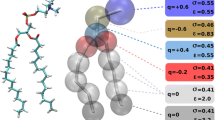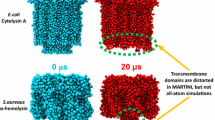Abstract
In coarse grained molecular dynamics (CGMD) simulations, small groups of atoms are treated as single particles (beads) and the forces between these particles are derived from the interatomic forces. The effect of this is to severely reduce the number of particles in a simulation, thereby allowing for the consideration of a larger number of atoms. It has also proven to be a valuable tool in probing time and length scales of systems beyond that used in all-atom molecular dynamics (AAMD) simulations. The down side of this is that the inter-particle interactions are less accurate. However, if these coarse grained particles are chosen carefully, such simulations can provide much useful information. There are different levels of how the coarse grains are constructed. For example, CG systems have been developed using tens or hundreds of atoms per CG bead in some studies of amino acids in biological science. By contrast, for other systems, a single CG bead is used to replace just two or three atoms.
In this paper, the interaction of a carbon nanotube (CNT) with a lipid bilayer membrane is studied using both coarse grained and atomistic MD in an effort to understand the usefulness of the CGMD method for such simulations. Our preliminary studies of the interaction of a CNT with a lipid bilayer points indicates that such nano-tubes inserted into a membrane could be stable. This means that it could be used as an agent in the delivery of drugs. It would be good if these simulations could be repeated using AAMD simulations to confirm the validity of these results.
Similar content being viewed by others
References
A. E. Porter, M. Gass, J. S. Bendall, K. Muller and A. Goode, ACS Nano, 3, 1485 (2009).
J. Wong-Ekkabut, et al, Nat. Nanotech., 3, 363 (2008).
K. Kostarelos, A. Bianco and M. Prato, Nat. Nanotech., 4, 627 (2009).
Z. Gburski, K. Gorny and P. Raczynskii, Solid State Commun., 150, 415 (2010).
J. C. Phillips et al, J. Comput. Chem., 26, 1781 (2005).
W. Humphrey, A. Dalke and K. Schulten, J. Mol. Graph., 14, 33 (1996).
S. J. Marrink, et al, J. Phys. Chem. B, 111, 7812 (2007).
L. Monticelli, J. Chem. Theory Comput. 8, 1370, (2012).
R. O. Salih and C. C. Matthai, J. Chem. Phys., 146, 105101 (2017).
N. Kucerka, S. Tristram-Nagle and J. F. Nagle J. Membr. Biol., 208, 193 (2006).
Author information
Authors and Affiliations
Rights and permissions
About this article
Cite this article
Salih, R., Matthai, C.C. Coarse Grained Molecular Dynamic Simulations of the interaction a Carbon Nanotube with a Bilayer Membrane. MRS Advances 2, 2603–2608 (2017). https://doi.org/10.1557/adv.2017.304
Published:
Issue Date:
DOI: https://doi.org/10.1557/adv.2017.304




